Most travel days are routine. By now, we know what to expect, and the expected usually happens. Plus, we can cope with minor misadventures. Some days, however – well, some days bring big surprises.
After a week soaking in the splendid scenery of northwest Wyoming, we were ready to move on to Idaho. I rose early Monday morning – 4:45! – to spend three hours driving around Grand Teton National Park making photographs of mountains and wildlife. Soon after I returned to camp, Kim and I rolled south toward our next adventure.
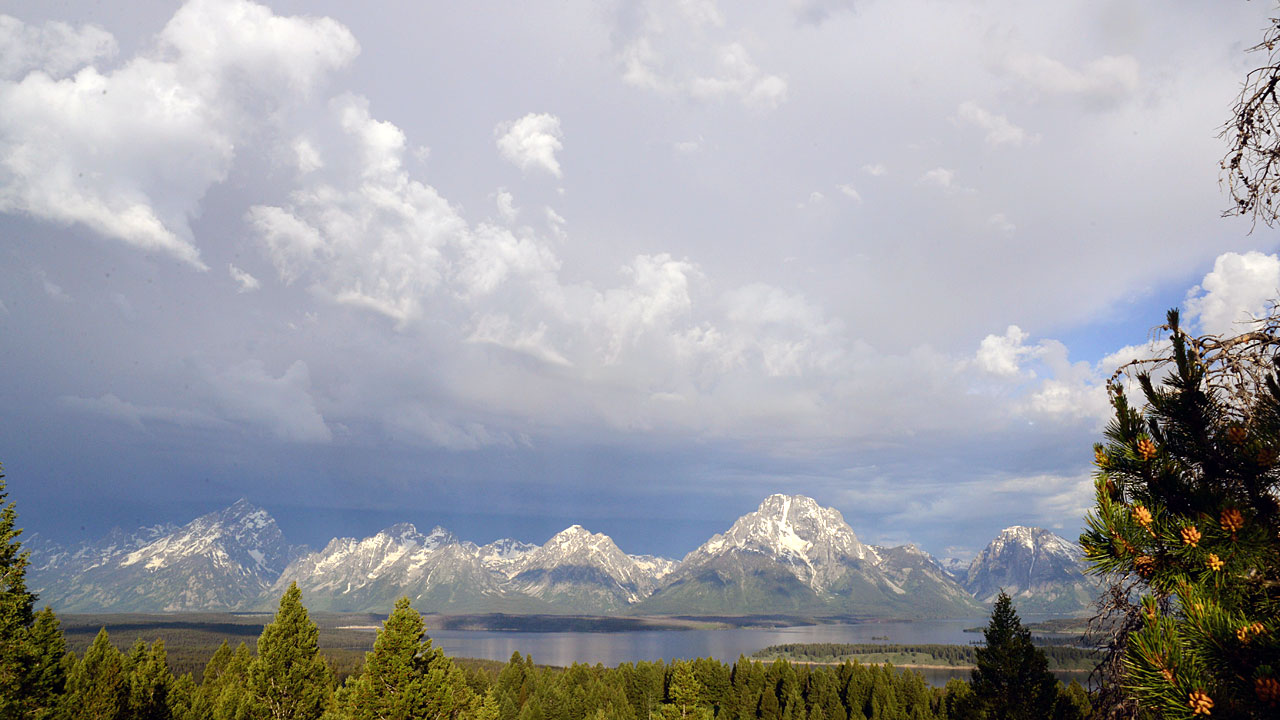
Morning in Grand Teton National Park (photo from top of Signal Mountain)
A Slow Start
We hadn’t even left the campground when we had our first taste of trouble. I was driving the motorhome and Kim was following in the Mini Cooper until we could find a place to hitch up. Except that when I looked behind me, she was no longer following. I stopped by the side of the road and waited. Kim drove up a few minutes later.
“Something’s wrong with the bike rack,” she said. “I had to stop because the straps had caught on a branch, and I was dragging it behind me.” Sure enough. Somehow the bike rack had come loose. The bikes were slipping as the straps slackened.
“Wow,” I said as I pulled off the bikes and re-tightened everything. “If we had just hitched up and gone, we never would have known this was a problem. The bikes would have simply fallen off behind us.” A potential disaster averted!
We drove south through the park and into Jackson, Wyoming (which is more commonly known as “Jackson Hole”, although that apparently refers to the larger community). From there, we took Highway 22 west – up into the mountains. “No trucks over 60,000 GVW,” the road signs warned. “Ten percent grade ahead.”
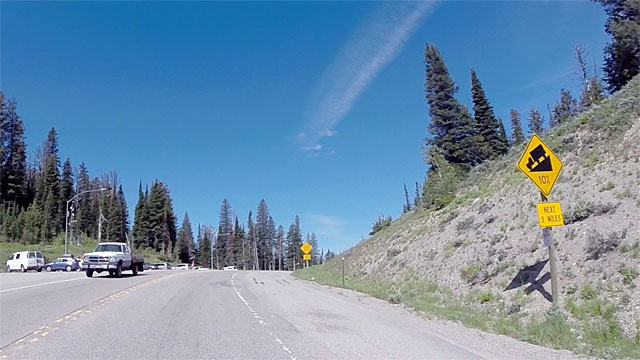
Warning sign at the top of Teton Pass (detail of GoPro screencap)
A ten percent grade! Grades of six percent are steep enough to merit warning signs – and sometimes long five percent grades are flagged. The worst we’d faced on the trip so far were a couple of short eight percent grades in Arizona and Colorado.
“Just go slow,” Kim said. “Keep it in low gear.” That I did. I had to. In Drive, the RV could not maintain momentum. It lost speed. Even in third, the speed slipped slowly from 40 to 30 to 20. In fact, there were some sections of the climb during which second gear couldn’t cope; I had to shift into first for short bursts in order to make it to the top. But we made it up. Then I kept the vehicle in low gear as we descended the back side of the mountains – another ten percent grade.
In Idaho now, we wound our way through rolling hills while listening to classic country music (our genre of choice while driving). Near Swan Valley, the hills gave way to green valleys filled with farms. We followed the Snake River into Idaho Falls, then drove west toward central Idaho. The farmland gave way to…well, I don’t have a word for it. Scrubland? High desert? Wasteland? In any event, the farms disappeared and were replaced by nothingness. We passed Atomic City and a national nuclear energy museum. (I learned later that this was part of Idaho National Laboratory, and that we’d driven by an experimental breeder reactor.)
A Wrong Turn
When we reached the town of Arco, we had to make a decision. “Should we head west to Shoshone?” I asked. “There may be hot springs there. I know there’s an ice cave. And there’s Craters of the Moon National Monument.”
“I don’t know,” Kim said. “None of that really interests me. I’d rather get closer to Sun Valley.” We planned to meet her father there in a few days.
“Me too,” I said. “And I feel fine.” As a general rule, we try to keep travel days to five hours or less. Any more and we get punchy. We’d already been driving 4-1/2 hours at this point, but I didn’t feel tired (despite the fact that I’d woken before five to take photos).
“Well, let’s head to Sun Valley,” Kim said. She plugged the destination into my phone. “Should we get gas while we’re in Arco?” she asked.
“Not yet,” I said. “I think we have enough to reach Sun Valley. Besides, the map shows several towns between here and there.”
Following the phone’s directions, I drove northwest on Highway 93 into yet more nothingness. At least here, however, there were signs of life. Homes dotted the roadside and valleys. Cattle grazed contentedly. We passed several small communities, though none could properly be called a town.
“Do you think you should get gas here?” Kim asked as we passed through Mackay. I checked the gauge.
“Nah, I still think we’re good,” I said. And here our troubles began.
At Least There Are Goats
We continued northwest. The few houses turned to no houses. Traffic vanished to nothingness. Soon we came to the Sun Valley junction, a turn to the southwest. We entered National Forest land. Sometimes, as in this case, the “forest” of the National Forest is almost nonexistent. For twenty miles or more, we drove through empty valleys labeled “open range”. But there were no trees, no cattle, no people – no nothing.
“I don’t like the looks of this,” I said as the road continued to narrow. “It feels like this is going to turn into a dirt road.” And sure enough, in a few miles, it did. “Not maintained for passenger vehicles,” a road sign cautioned. “Trailers not recommended.”
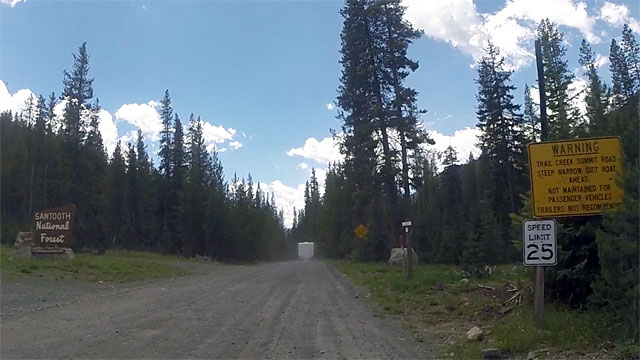
Warning sign on Trail Creek Summit Road (detail of GoPro screencap)
“What do you think?” Kim asked. Though I was tired and starting to get fussy, she was surprisingly calm. (We’re both good at this: If one of us is tired or stressed or out of sorts, the other almost always steps up, acts as a rock.)
“I think it’ll take us three hours or more to drive back around to reach Sun Valley from the other side. According to my phone, we’re only twenty miles away right now. And that dirt road doesn’t look so bad. We’ve done worse on this trip.”
“Not in the RV,” Kim said. “Besides, how much gas do you have?”
“Not much,” I admitted.
“Let’s give it a shot,” Kim said. It’s a funny thing. When you travel in a motorhome, you’re willing to take more risks than you might otherwise do. You have your home “on your back”, so to speak. You know that if something goes wrong – you run out of gas, you get a flat tire – you can always pull over and stay the night where you are.
We unhitched the Mini.
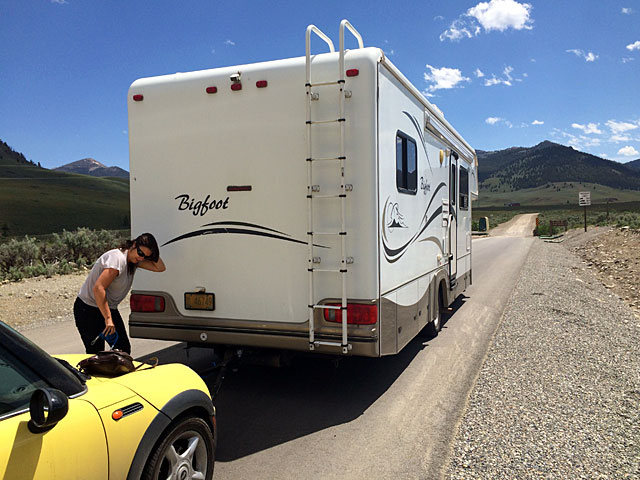
Kim unhitches the Mini where the blacktop ends…
We followed the dirt roads for several miles, bouncing over cattle guards and potholes and washboarding. Then, as we’d feared, the “low fuel” light indicator came on in the RV. I stopped to tell Kim the bad news. She was unfazed.
“There’s a campground just up here,” she said. “Let’s check it out.” Turns out, the spot was perfect, the kind of place we might have picked even if necessity hadn’t forced our hand.
The Phi Kappa Campground is a National Forest campground situated in a stand of tall trees next to a small stream. It’s typical of the spots we’ve stayed on this trip – except that it seems severely disused. Rodent holes and burrows honeycomb the entire campground. Individual campsites are overgrown with brush and trees. The pit toilets are clean – except for a thick layer of dust covering everything. And the payment slot has been covered by duct tape.
“Well, that’s a good deal,” I said. “Instead of ten bucks to stay the night, I guess we get to stay for free.”
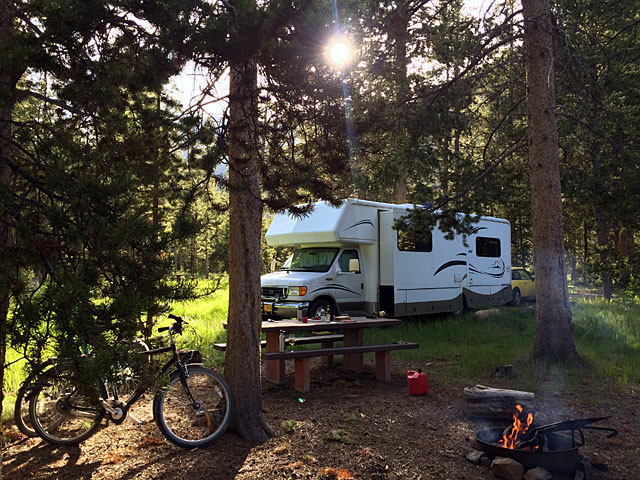
Not bad for a $10 campsite — and even better when it’s free!
We had a great evening. Although we could hear occasional traffic from the road, we were all alone in the campground. Kim cooked up steaks and veggies while I kept us supplied with beer and wine. I lit a fire and Kim kept it going. We sat outside and chatted as the sun sank low in the sky. We listened to our transistor radio. Just before sunset, I noticed some white flecks on a nearby hillside. The white flecks were moving.
“I think those might be mountain goats,” I said.
“Where?!?” she said, and she sprinted to grab the binoculars. For three months, she’s wanted to see mountain goats. Despite having passed through prime mountain goat territory, she hadn’t seen a single one. Until now. There on the hillside was a large group of them: four adults and three babies.
We went to bed happy.
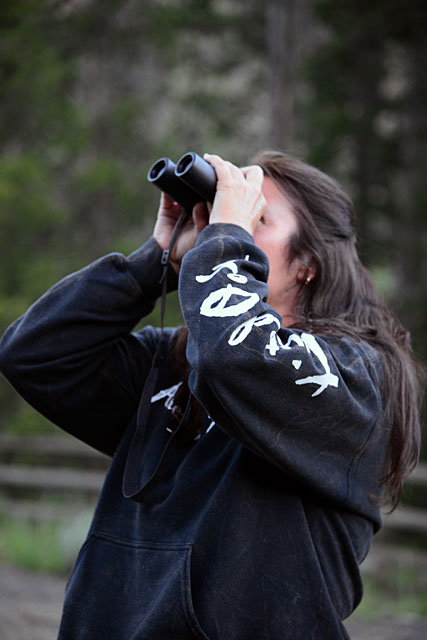
Goats! There are goats!
A Rocky Road
In the morning, we exercised. While Kim worked out in camp, I biked up the road to scope things out. “I think we’re good,” I said during breakfast. “The road doesn’t get any worse, and we’re close to the summit.” We hopped in the Mini Cooper and drove to town to get gas. I was right: The road didn’t get much worse – except that the other side of the pass wasn’t flat, as it had been on the east side of the mountain. Instead, the road dropped sharply into Sun Valley.
“Wow,” Kim said. “This is almost as steep as the road we drove yesterday.”
When we reached a gas station, our troubles continued. I filled the two gallon tank easily enough, but then noticed a small stream of gasoline seeping out the side. The service station attendant came to our rescue.
“You can use our can,” he said, “but you have to bring it back.”
“We will,” Kim said. “We just need to put a bit of fuel in our RV. It’s on the other side of the summit. We were on our way here when we ran out of gas last night.”
“Be careful,” the attendant said. “That road is notorious for popping tires. They try to keep it clean, but shale falls from the mountainside and chews up small cars for breakfast.”
As we drove back toward the mountain, we stopped to scout a campground on the edge of town. While reserving a spot with the camp host, we told him what we were going through. He laughed at our story. “Stuff like this happens to all RVers,” he said. “It’s just part of the lifestyle. Part of the adventure.”
He looked at our dirty, dinged-up Mini Cooper. “I’m impressed you came over the pass in that,” he said, “and that you’re going to try it in your motorhome. My wife is convinced that nothing less than a tank can cross the summit. We’ve heard too many stories from folks who’ve had blowouts because of the shale.”
On our drive into town, we hadn’t really worried about the rocks in the road. We were more worried about the road itself: how narrow it was, how steep the grade was, how the road twisted and turned and how the drop off the side fell thousands of feet into the valley below. Now, though, after warnings from two different people, we paid attention to the rocks in the road. Sure enough: there was plenty of sharp shale, some large enough to tear up a tire.
Thanks to Kim’s always excellent driving, we made it back to the motorhome without incident. We poured in our two gallons of gas, and then started back over the mountain. We drove s-l-o-w-l-y. We took our time. We reached the summit and started down into Sun Valley. Twice we had to pull over to the cliff-side of the road in order to allow large loads to get by on the inside. We crept cautiously over the shale. After nearly half an hour, we reached asphalt.
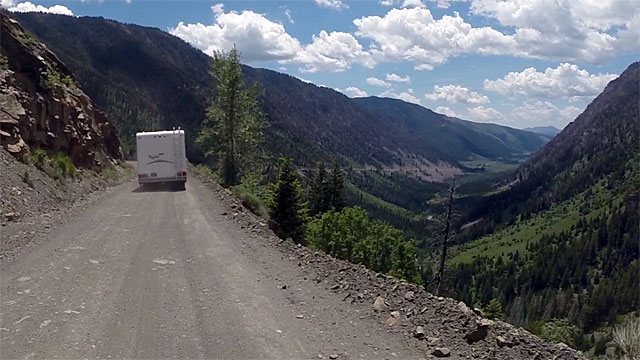
The drop down into Sun Valley on Trail Creek Summit Road
“Did the GoPro get all of that?” I asked. We’ve begun to make a habit of recording interesting drives.
“Almost,” Kim said. “It died a few minutes ago.” We love our GoPro, but battery life on that thing sucks. We carry three batteries, and that’s still not enough to properly document most interesting trips. We’ve heard many others voice similar complaints.
By two o’clock, we’d arrived at our campground, safe and sound. Despite dumb directions from my phone and poor fuel management on my part, we’d made it to Sun Valley unscathed.
A Lesson Learned?
Probably the largest lesson from this story is: Be prepared. Kim and I talk about this all of the time. On a year-long RV trip, you can’t plan for everything. Plus, you don’t want to over-plan (which is a bigger problem than you might guess). Still, it’s important to be like a Boy Scout, to take sensible precautions and to prepare for likely scenarios. I was dumb not to have fueled the RV when it was easy and painless to do so. Failing to prepare led to failure.
That said, there’s another lesson here, and it’s one that gets to the core of our shared philosophy as a couple. Kim and I both believe that it’s important to “go with the flow”, to be adaptable. Travel is tough for a lot of folks who want to adhere to rigid timelines and set agendas. When traveling, you must expect the unexpected. Moreover, it’s generally best to leave room for unplanned adventures, for happy surprises, for serendipity.
To my mind, it’s these unplanned and unexpected events that bring the most joy to travel. When you’re open to anything, then anything can happen.
{ 1 comment… read it below or add one }
Great story, but you missed out on Craters of the Moon. My family loved it last summer.